Page 135 of 400
137
2−4. Using other driving systems
2
When driving
� Cruise control can be set when
� The shift lever is in D or 4 (vehicles with an automatic transmission).
�Vehicle speed is between approximately 25 mph (40 km/h) and 125 mph
(200 km/h).
� Accelerating
The vehicle can be accelerated normally.
�Automatic cruise control cancelation
The set speed is automatically cancelled in any of the following situations.
�Actual vehicle speed falls more than 10 mph (16 km/h) below the preset
vehicle speed.
At this time, the memorized set speed is not retained.
� Actual vehicle speed is below 25 mph (40 km/h).
�
VSC is activated.
� Canceling and resuming regular acceleration
Cancel
Pull the lever towards you to
cancel cruise control.
The speed setting is also can−
celed when the brakes are
applied or the clutch
depressed (manual transmis−
sion).
Resume
To resume cruise control and
return to the set speed, push
the lever up.
Page 136 of 400
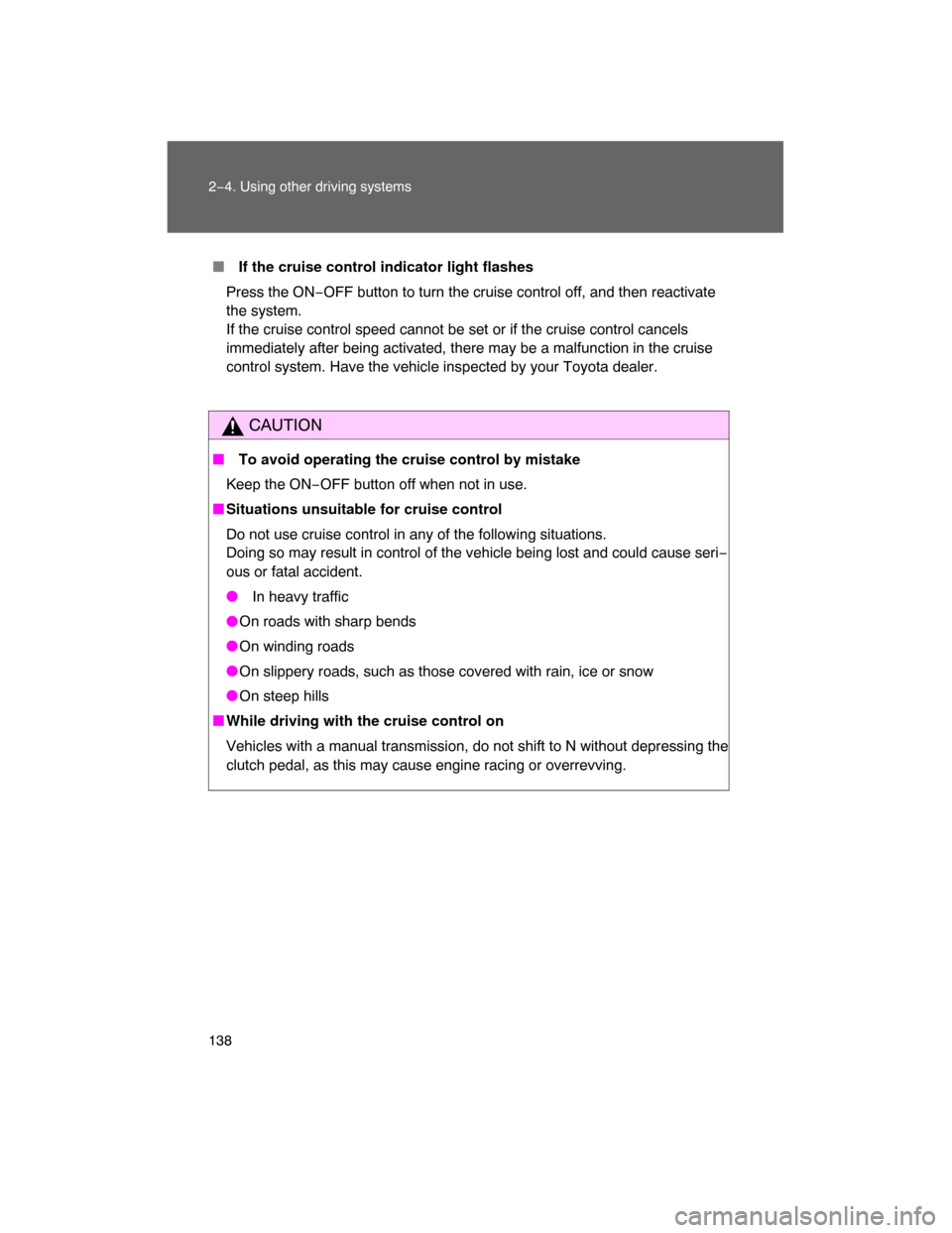
138 2−4. Using other driving systems
� If the cruise control indicator light flashes
Press the ON−OFF button to turn the cruise control off, and then reactivate
the system.
If the cruise control speed cannot be set or if the cruise control cancels
immediately after being activated, there may be a malfunction in the cruise
control system. Have the vehicle inspected by your Toyota dealer.
CAUTION
� To avoid operating the cruise control by mistake
Keep the ON−OFF button off when not in use.
�Situations unsuitable for cruise control
Do not use cruise control in any of the following situations.
Doing so may result in control of the vehicle being lost and could cause seri−
ous or fatal accident.
� In heavy traffic
�On roads with sharp bends
�On winding roads
�On slippery roads, such as those covered with rain, ice or snow
�On steep hills
�While driving with the cruise control on
Vehicles with a manual transmission, do not shift to N without depressing the
clutch pedal, as this may cause engine racing or overrevving.
Page 143 of 400
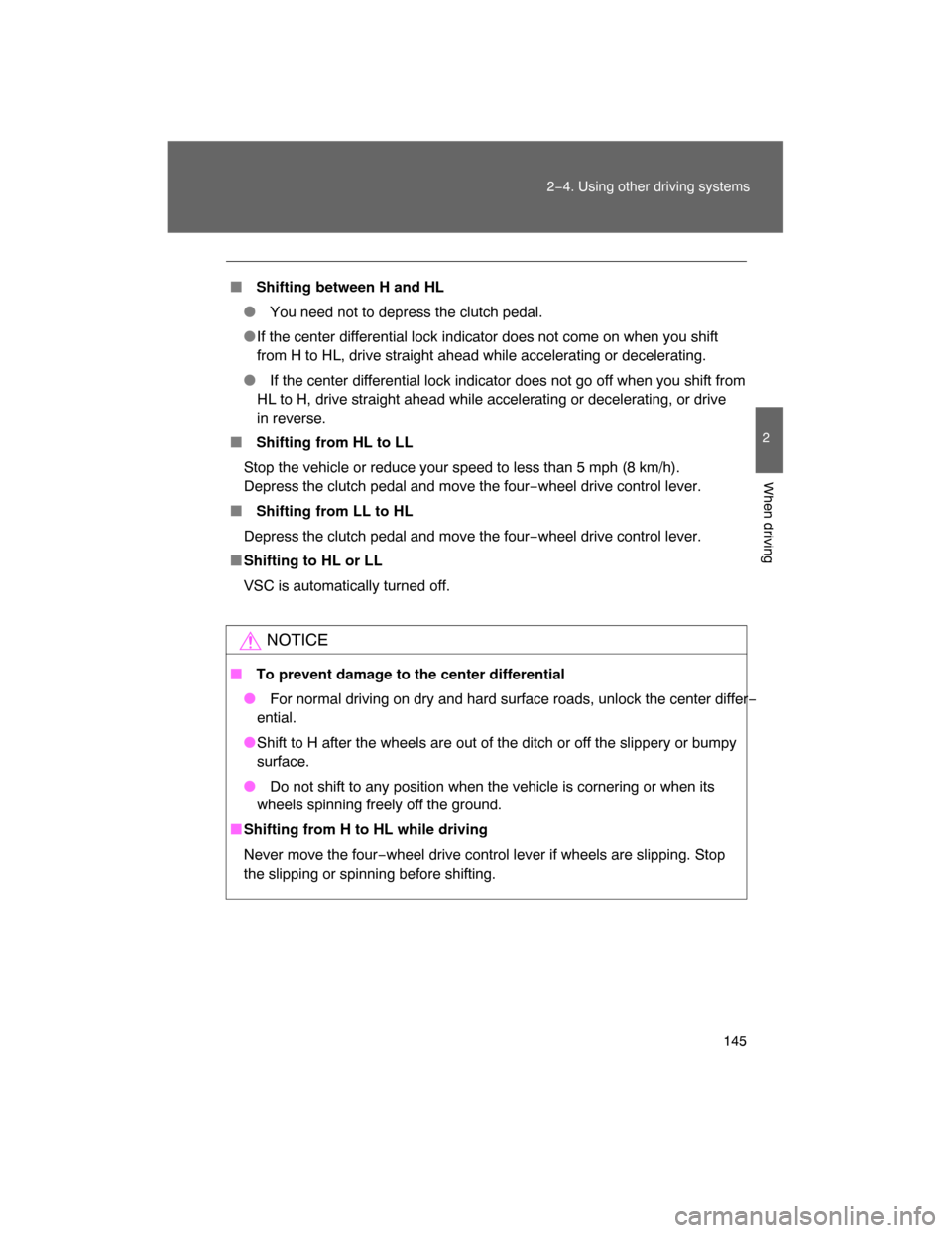
145
2−4. Using other driving systems
2
When driving
� Shifting between H and HL
� You need not to depress the clutch pedal.
�If the center differential lock indicator does not come on when you shift
from H to HL, drive straight ahead while accelerating or decelerating.
� If the center differential lock indicator does not go off when you shift from
HL to H, drive straight ahead while accelerating or decelerating, or drive
in reverse.
� Shifting from HL to LL
Stop the vehicle or reduce your speed to less than 5 mph (8 km/h).
Depress the clutch pedal and move the four−wheel drive control lever.
� Shifting from LL to HL
Depress the clutch pedal and move the four−wheel drive control lever.
�
Shifting to HL or LL
VSC is automatically turned off.
NOTICE
� To prevent damage to the center differential
� For normal driving on dry and hard surface roads, unlock the center differ−
ential.
�Shift to H after the wheels are out of the ditch or off the slippery or bumpy
surface.
� Do not shift to any position when the vehicle is cornering or when its
wheels spinning freely off the ground.
�Shifting from H to HL while driving
Never move the four−wheel drive control lever if wheels are slipping. Stop
the slipping or spinning before shifting.
Page 151 of 400
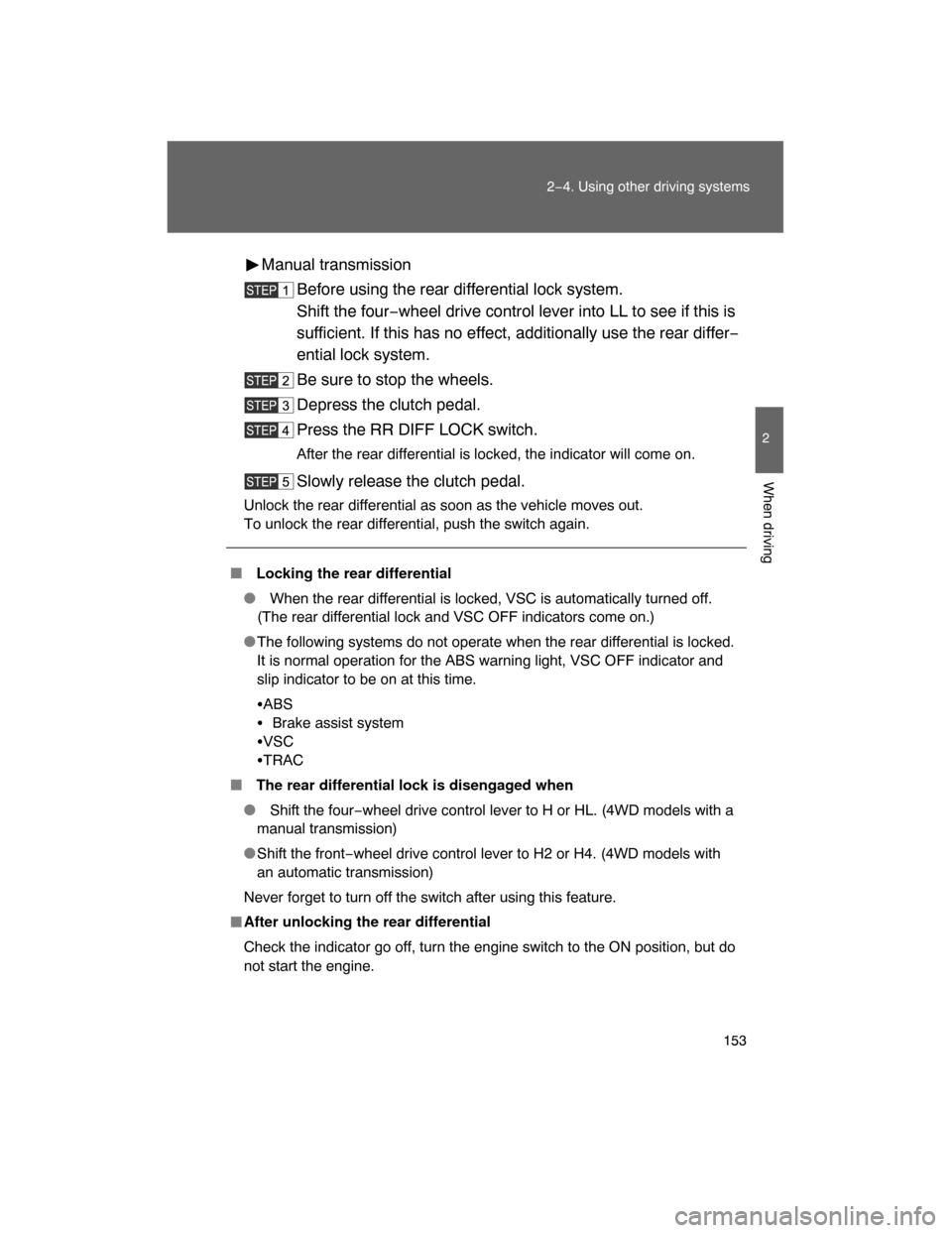
153
2−4. Using other driving systems
2
When driving
Manual transmission
Before using the rear differential lock system.
Shift the four−wheel drive control lever into LL to see if this is
sufficient. If this has no effect, additionally use the rear differ−
ential lock system.
Be sure to stop the wheels.
Depress the clutch pedal.
Press the RR DIFF LOCK switch.
After the rear differential is locked, the indicator will come on.
Slowly release the clutch pedal.
Unlock the rear differential as soon as the vehicle moves out.
To unlock the rear differential, push the switch again.
� Locking the rear differential
� When the rear differential is locked, VSC is automatically turned off.
(The rear differential lock and VSC OFF indicators come on.)
�The following systems do not operate when the rear differential is locked.
It is normal operation for the ABS warning light, VSC OFF indicator and
slip indicator to be on at this time.
�ABS
�Brake assist system
�VSC
�TRAC
� The rear differential lock is disengaged when
� Shift the four−wheel drive control lever to H or HL. (4WD models with a
manual transmission)
�Shift the front−wheel drive control lever to H2 or H4. (4WD models with
an automatic transmission)
Never forget to turn off the switch after using this feature.
�After unlocking the rear differential
Check the indicator go off, turn the engine switch to the ON position, but do
not start the engine.
Page 153 of 400
155
2−4. Using other driving systems
2
When driving
Clutch star t cancel switch (vehicles with a manual transmission)
� Clutch start system
The system is designed to keep the starter motor from operating if the clutch
pedal is not depressed all the way down. The switch allows the vehicle to be driven out of difficult situations
by cranking the engine with the clutch engaged.
Never use the switch for normal engine starting. Be sure to follow the
starting procedure. ( P. 114)
Press the CLUTCH START
CANCEL switch to cancel the
clutch start system with the
engine switch is turned to the
ON position.
The indicator comes on when
the clutch start system is can−
celed.
The clutch start cancel switch
is automatically turned off
when the engine switch is
turned off.
Page 178 of 400
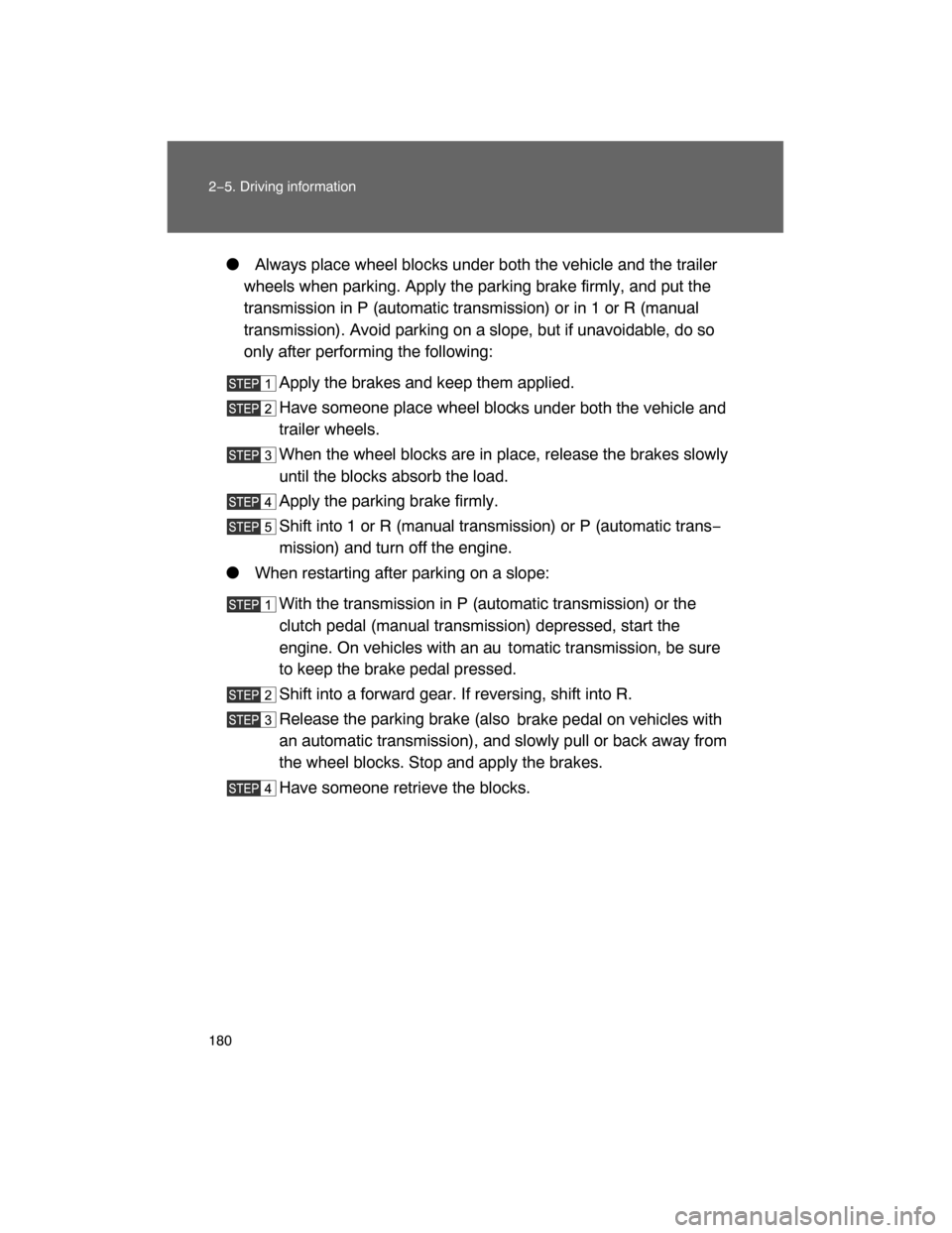
180 2−5. Driving information
� Always place wheel blocks under both the vehicle and the trailer
wheels when parking. Apply the parking brake firmly, and put the
transmission in P (automatic transmission) or in 1 or R (manual
transmission). Avoid parking on a slope, but if unavoidable, do so
only after performing the following:
Apply the brakes and keep them applied.
Have someone place wheel bloc
ks under both the vehicle and
trailer wheels.
When the wheel blocks are in place, release the brakes slowly
until the blocks absorb the load.
Apply the parking brake firmly.
Shift into 1 or R (manual transmission) or P (automatic trans−
mission) and turn off the engine.
� When restarting after parking on a slope:
With the transmission in P (automatic transmission) or the
clutch pedal (manual transmission) depressed, start the
engine. On vehicles with an au tomatic transmission, be sure
to keep the brake pedal pressed.
Shift into a forward gear. If reversing, shift into R.
Release the parking brake (also
brake pedal on vehicles with
an automatic transmission), and slowly pull or back away from
the wheel blocks. Stop and apply the brakes.
Have someone retrieve the blocks.
Page 238 of 400
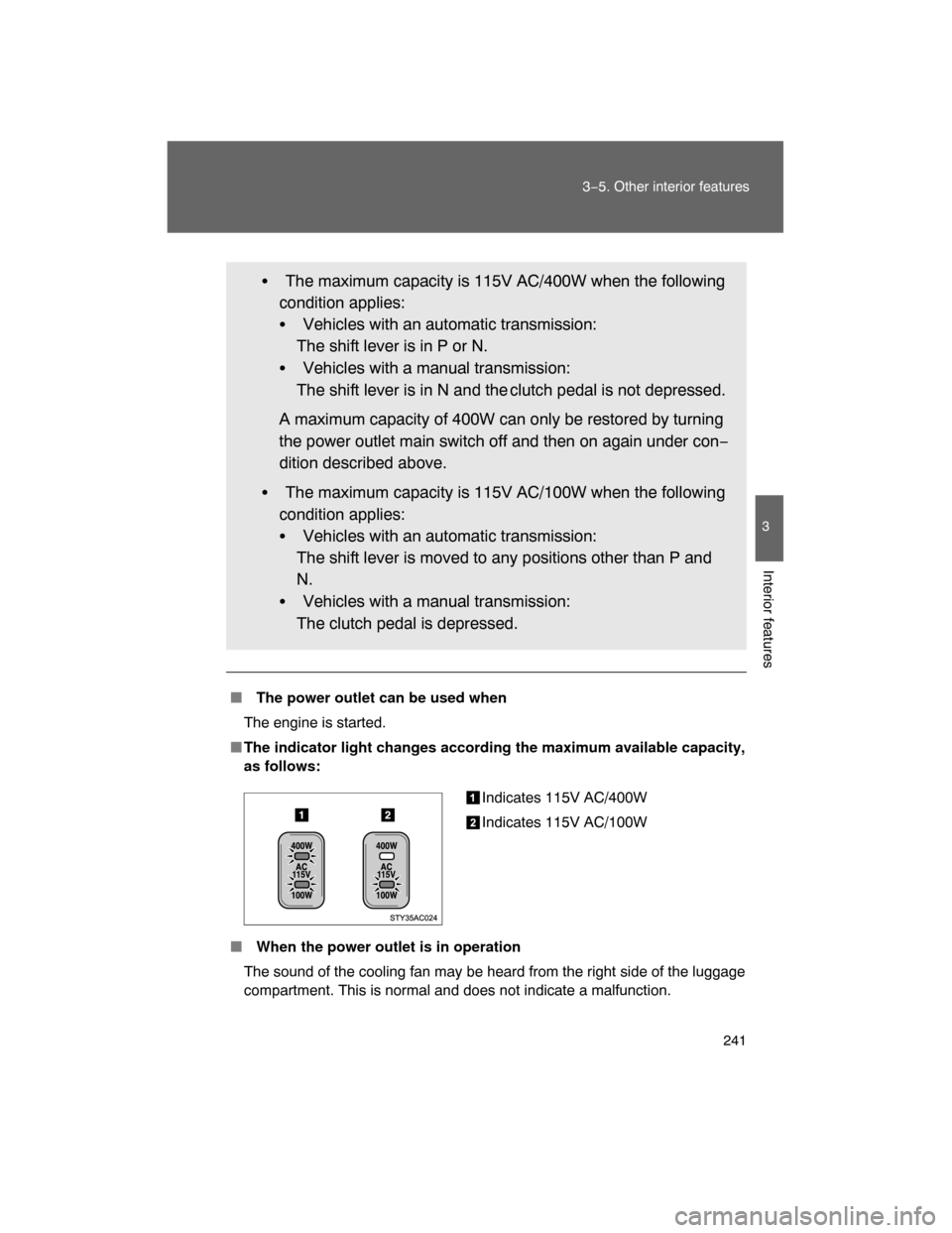
241
3−5. Other interior features
3
Interior features
� The power outlet can be used when
The engine is started.
�The indicator light changes according the maximum available capacity,
as follows:
� When the power outlet is in operation
The sound of the cooling fan may be heard from the right side of the luggage
compartment. This is normal and does not indicate a malfunction.
�The maximum capacity is 115V AC/400W when the following
condition applies:
�Vehicles with an automatic transmission:
The shift lever is in P or N.
�Vehicles with a manual transmission:
The shift lever is in N and the clutch pedal is not depressed.
A maximum capacity of 400W can only be restored by turning
the power outlet main switch off and then on again under con−
dition described above.
�The maximum capacity is 115V AC/100W when the following
condition applies:
�Vehicles with an automatic transmission:
The shift lever is moved to any positions other than P and
N.
�Vehicles with a manual transmission:
The clutch pedal is depressed.
Indicates 115V AC/400W
Indicates 115V AC/100W
Page 239 of 400

242 3−5. Other interior features
� If the engine is started with the power outlet main switch on
The maximum capacity of the power supply may decrease to below the stan−
dard, or may be cut off completely, even when the vehicle is stationary.
� The protection circuit may be activat ed to cut the power supply if any
of the following conditions apply:
�The engine is started with the power outlet main switch on.
�Use of electrical appliances exceeding the maximum capacity is
attempted.
A sound may be heard when the protection circuit is activated.
This is normal and does not indicate a malfunction.
� Electrical appliances, which consume power exceeding 100W, have
been used continuously for a long time period.
�The total power usage by all electrical features (headlights, air condition−
ing, etc.) has exceeded the total vehicle maximum for an extended
period of time.
� If the protection circuit is activated
and the power supply is cut, con�
duct the following procedure:
Park the vehicle in a safe place, and then securely apply the park−
ing brake.
Check and ensure the following conditions
Vehicles with an automatic transmission:
The shift lever is in P or N.
Vehicles with a manual transmission:
The shift lever is in N and the clutch pedal is not depressed.
Make sure that the power consumption of the electric appliance is
within the maximum capacity of the power outlet and the appliance
is not broken.
Press the power outlet main switch again.
When the cabin temperature is high, open the windows to cool the tempera−
ture down. Once it reaches the normal temperature, turn the power outlet
main switch on again.
If the power supply is not resumed even after performing the above proce−
dure, have the vehicle inspected by a Toyota dealer.